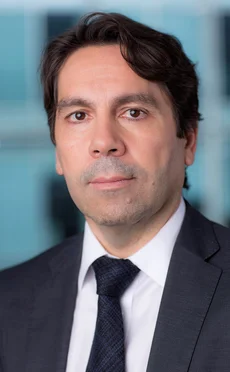
This article was paid for by a contributing third party.More Information.
A new risk era – Recovering stronger from the pandemic

Jose Ribas, global head of risk and pricing solutions at Bloomberg, discusses how risk management at financial institutions is changing in the wake of the pandemic and the subsequent volatility, the role of regulations and how technology can help risk teams be more agile
What does the Covid-19 pandemic – and the resulting volatility and market stress – reveal about the robustness of financial institutions’ risk systems?

Jose Ribas: The level of volatility and trading activity seen over a short space of time in March was unprecedented. Negative interest rates, negative commodity prices and price volatility required risk management teams to act more swiftly and run valuations and risk assessments more frequently. The rising credit risk triggered margin calls, credit valuation adjustments and end-of-day valuations, and resulted in a greater number of disputes. All of this activity stressed systems and teams. The need to respond rapidly and manage risk with greater intraday frequency has become fundamental to the market.
Firms also had to ensure, with very short notice, that their systems could support the majority of their workforce working from home. For risk managers, the challenge is that they need to understand their exposure – and whether or not limits have been breached – at any time. Huge computing power is needed to calculate the portfolio risk numbers on an intraday basis. With teams working remotely, there is greater potential for gaps to occur, as firms are still required to record conversations and provide a solid audit trail. We saw a spike in demand from Bloomberg customers asking us to provide quick solutions to aid this type of business continuity.
And this is not just happening at financial firms. Corporations that use hedge accounting or, for example, hold oil contracts also need to hedge their exposures. During the worst of the volatility, what they believed were eligible or effective hedges became ineffective. They are now also paying more attention to the heightened risk of defaults in their customer base and supply chains.
Risk management is taking centre stage at board meetings, with chief risk officers (CROs) and risk managers in the spotlight, as firms realise they must respond rapidly. If you have four systems, it takes time to reconcile positions and risk numbers – the process won’t be as efficient as using a single system with a streamlined workflow that provides consistency between the front office and risk functions. Implementing new models to deal with unexpected market events – such as low or negative oil prices – is also quicker and easier if you don’t have multiple systems.
Some of the regulations prompted by the global financial crisis that began in 2007–08 are still being implemented. Will another wave of regulation help or hinder firms’ risk management efforts?
Jose Ribas: Regulators have been fairly accommodating in the current circumstances. They have pushed back deadlines for some regulations such as the Fundamental Review of the Trading Book (FRTB), and they have been more lenient in terms of capital requirements to make sure there’s credit available. But that doesn’t mean firms have stopped focusing on implementation. We haven’t seen any significant delays from customers in terms of planning, it just gives them a bit more breathing space to channel their resources effectively.
While some firms focus on regulatory compliance, many go above and beyond regulatory standards in terms of their own processes and risk controls. Some also seek to stay ahead of the game with improvements to models, metrics and analytics. For example, firms that didn’t have models to price commodities with negative rates will make sure they have one ready for next time rather than wait for the regulatory guidance.
Going forward, regulators may also start asking questions around firms’ response times during the crisis. They could inquire about value-at-risk (VAR) limits that have been breached and introduce new measures accordingly. Regulatory stress tests are already taking a more forward-looking approach, so we may see new scenarios introduced to explore how well and how quickly firms are positioned to respond.
How is the Covid-19 pandemic changing how firms manage data for regulatory compliance and reporting?
Jose Ribas: Data is fundamental to effective decision-making, and in crisis situations there is increased demand for quality data delivered at speed. Bloomberg saw a spike in the volume of customers accessing data across all key feeds. Firms need clean data on their positions and on markets, along with high-quality data for valuation and risk. They also need the right methods to continue to produce arbitrage free volatilities and curves in extreme market conditions. If high-quality data isn’t available because of liquidity challenges, firms will need to fill in the blanks using proxy methods. They need to be able to understand relationships between markets and how a particular financial investment has moved compared with others.
In terms of reporting output, while firms need to be able to make swift decisions on risk, they must also ensure that trading data is reported correctly. This requires validation processes and thus good technology. Transparency on the data and trust in the numbers is very important because firms are responsible for the output.
What questions should CROs be asking as they conduct postmortems on their crisis response and risk management practices?
Jose Ribas: CROs will be looking at VAR limit breaches, and at what can be done to get a better intraday, real-time or forward-looking view of exposures. Did they have access to the data they needed in order to make the right decisions at the right time? When these sorts of volatility levels come to the markets, latency is a real issue.
CROs should evaluate how long it takes them to gather data and reconcile systems, and evaluate how they could react faster, adjust hedges and identify sources of liquidity.
They should also consider how risk limits should change when the volatility of the market is changing. Do they need more agile portfolios? If you trade in and out of a position, you will have a higher cost of trading. If you trade less frequently, you may have more losses.
CROs may also look to drive efficiency in risk processes by outsourcing certain tasks, such as independent valuations, application programming interfaces (APIs) supporting certain tasks for the Libor transition or credit modules. What solutions do they want to build and maintain in-house, and what solutions and services can they outsource in order to focus on the decision-making?
While the role of the CRO has grown in importance since the last financial crisis, now we may see something similar happening with chief technology officers (CTOs). Firms increasingly realise they need to focus on streamlining systems – from pre-trade to trade execution, risk management, reporting and communication. How much time is spent reconciling because a firm has multiple systems? Depending on their size and the complexity of their operations, firms can have anywhere from a few to hundreds of systems. CROs and CTOs may need to assess if they are investing in the right technology and working with the right partners.
What do you consider the most likely source of the next financial crisis, and how can firms improve their ability to prepare and respond?
Jose Ribas: For now, risk teams will have to focus on reviewing how the economic impacts of the pandemic – and the fiscal and monetary policies put
in place to deal with it – will affect their risk scenarios and hedging strategies.
Looking ahead, while innovations in technology – such as robotic process automation and artificial intelligence – are good and necessary for the market, they need to be properly risk managed. You need strict rules governing these systems, someone validating the decisions and stopping the chain of wrong signals from escalating.
People sometimes question investment in risk technology and infrastructure, but it pays off. We have invested in making our own systems more robust; as a result they coped well despite volumes and volatility going up three or fourfold.
One of the lessons the market is learning from this pandemic is that having contingency plans and resources in place for more extreme scenarios is essential, and that using a reliable third-party provider makes sense if you don’t have the time, budget or resources to go at it alone.
While regulators have conceded ground on the timeline for several key legislative reforms, they have stressed that firms’ existing compliance responsibilities remain a priority. How can risk managers strike the right balance between firefighting, business as usual and strategic planning?
Jose Ribas: While crises create major challenges, they also force you to break out of your usual routine, and think and act differently. The 2007–08 crisis demonstrated to firms that trying to do everything in-house is not cost-effective and delays or reduces the time available for decision-making and planning.
As a result, firms re-examined their buy-versus-build approaches and started using more third-party providers. This trend is set to grow, with firms either continuing to review existing systems or considering more flexible solutions, such as APIs and services, to complement these. The events of the past few months have also reminded firms that having reliable partners and suppliers during difficult times is very important.
Notably, we see firms looking for more sophisticated credit and intraday risk tools, and automation solutions that remove lengthy manual processes and allow risk managers to spend more time on complex tasks that require human decision-making. Integrating front-office and risk management systems also frees up time by reducing reconciliation issues.
While there are still firms that are cloud-averse and prefer to keep all systems and servers on their own premises, the current situation with employees working remotely will likely change that thinking. All of these aspects will help firms focus on tactical as well as strategic goals.
How else will Covid-19 affect how risk teams operate in the future?
Jose Ribas: I think, across all teams, there will be greater awareness and understanding of colleagues’ personal circumstances, needs and mental wellbeing, which can only be a good thing. Working from home also forces team members to focus on improving how they communicate, which should help foster better collaboration.
Covid-19: Pandemic risk – Special report 2020
Read more
Sponsored content
Copyright Infopro Digital Limited. All rights reserved.
As outlined in our terms and conditions, https://www.infopro-digital.com/terms-and-conditions/subscriptions/ (point 2.4), printing is limited to a single copy.
If you would like to purchase additional rights please email info@risk.net
Copyright Infopro Digital Limited. All rights reserved.
You may share this content using our article tools. As outlined in our terms and conditions, https://www.infopro-digital.com/terms-and-conditions/subscriptions/ (clause 2.4), an Authorised User may only make one copy of the materials for their own personal use. You must also comply with the restrictions in clause 2.5.
If you would like to purchase additional rights please email info@risk.net
